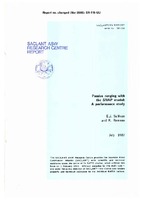| dc.contributor.author | Sullivan, Edward J. | |
| dc.contributor.author | Rameau, K. | |
| dc.date.accessioned | 2018-10-11T14:06:43Z | |
| dc.date.available | 2018-10-11T14:06:43Z | |
| dc.date.issued | 1987/07 | |
| dc.identifier | 1898 | |
| dc.identifier.govdoc | SR-118 | |
| dc.identifier.uri | http://hdl.handle.net/20.500.12489/286 | |
| dc.description.abstract | A passive ranging technique which uses SNAP, the SACLANT Centre's normal-mode model, is studied. An examination is made of the sensitivity of the technique to errors in the assumed sound | |
| dc.description.abstract | velocity profile and tilting of a 16 lambda vertical receiving array. Also, the effect of both white and | |
| dc.description.abstract | coloured noise is investigated. Results indicate that for the scenario considered (summer profile in the Mediterranean with a water depth of 130 m and source ranges of 10 and 25 km), the method can be quite robust to sound velocity profile errors on the order of several m/s and array tilts on the order of 1.5 deg . Solutions were obtained with input signal-to-noise ratios as low as -13 dB. | |
| dc.format | 21 p. : ill. ; 18 fig. | |
| dc.language | English | |
| dc.publisher | NATO. SACLANTCEN | |
| dc.relation.ispartofseries | ADA183486 | |
| dc.subject | SNAP-RD (acoustic propagation model) | |
| dc.subject | Noise | |
| dc.subject | Sound velocity in sea water | |
| dc.subject | Acoustic propagation | |
| dc.subject | Mediterranean Sea | |
| dc.title | Passive ranging with the SNAP model: a performance study | |
| dc.type | Scientific Report (SR) | |
